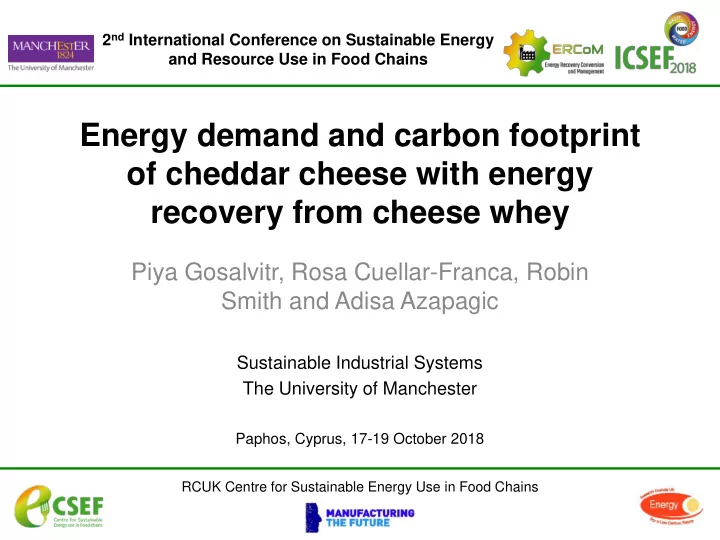

2 nd International Conference on Sustainable Energy and Resource Use in Food Chains Energy demand and carbon footprint of cheddar cheese with energy recovery from cheese whey Piya Gosalvitr, Rosa Cuellar-Franca, Robin Smith and Adisa Azapagic Sustainable Industrial Systems The University of Manchester Paphos, Cyprus, 17-19 October 2018 RCUK Centre for Sustainable Energy Use in Food Chains
Overview of cheese production and consumption World cheese producers $124.20 billion by 2022 Cheese production in the UK
Cheddar production process Rennet 0.7 g Calcium chloride 1 g Milk 10 kg Saltpetra 3 g Pasteurisation Coagulation Curd cutting Whey 9 kg & whey drainage Salt 20 g Cheddaring Cheddar cheese 1 kg Packaging Pressing & Storage packaging
Cheddar cheese whey Cheese whey 22.8 kg, Buffer solutions Digestate Anaerobic digestion 0.023 m 3 Biogas 1 m 3 (55 % methane content) BOD: 27-60 g/l COD: 50-102 g/l Ref : Carvalho et al., 2013, Cheese whey wastewater: Characterization and treatment Ref : Carvalho et al., 2013, Cheese whey wastewater: Characterization and treatment
Aims and objectives • To assess the impacts of cheddar cheese with energy recovery from whey through anaerobic digestion • To identify the hotspots and make recommendations for improvements
Methodology Process simulation Cheese production process Aspen Plus Life cycle assessment System boundary: cradle to grave Functional unit: 1 kg of cheddar cheese produced and consumed in the UK GaBi 8.6; Ecoinvent 3.3 Recipe 2016 impacts + primary energy demand
System boundary Emission Electricity to grid Cheddar cheese factory Milk production Milk reception and T at farm storage Combined Heat Heat and Power Electricity Plant Landfill Milk pasteurization Biogas Coagulation, Curd cutting, Anaerobic Wastewater T Cooking and Digestion plant treatment plant Wastewater whey Cheddaring Cheddar Regional cheese Packaging and T T Retailer Home T Distribution storage T = transportation Centre Raw materials, Water, Chemicals and Energy
Aspen simulation 𝑈 = 30 ℃ 𝑈 = 4 ℃ 𝑈 = 68 ℃ Heat in integration 𝑁𝐾 r 𝑓𝑒𝑣𝑑𝑓 𝑓𝑜𝑓𝑠𝑧 𝑑𝑝𝑜𝑡𝑣𝑛𝑞𝑢𝑗𝑝𝑜 = 4.46 𝑙 𝑑ℎ𝑓𝑒𝑒𝑏𝑠 𝑈 = 38 ℃ 𝑈 = 90 ℃
Energy sources: comparison with the literature 10 9 8 7 3.83 Energy (MJ/kg) 6 Energy 5 reduction 4.46 4 from heat 3.82 3 integration 4.92 2 1.38 1 1.74 0.82 0 Kim et al. Aguirre-Villegas et al. This study Electricity (grid) Thermal energy (unspecified source) Electricity (whey biogas) Heat (whey biogas)
Energy flow in the cheese factory Heat credit : 1.58 MJ 1.38 MJ heat 0.62 MJ heat Heat produced : 3.58 MJ Cheese Combined Cheddar Anaerobic Biogas cheese whey production heat and digestion process power Electricity produced : 3.04 MJ elec. 0.12 MJ elec. 0.82 MJ elec. Electricity credit: 2.1 MJ elec. CHP efficiency: 85 % (39 % for electricity, 46 % for heat)
Carbon footprint 14 11.78 Carbon footprint (kg CO 2 eq./kg) 12 14 11.89 11.78 Carbon footprint (kg CO 2 eq./kg) 9.43 10 12 9.43 10 8 8 6 6 4 4 1.54 2 1.54 2 0.33 0.41 0.22 0.42 0.23 0.17 0.16 0.12 0.09 0.23 0.17 0.22 0.04 0.16 0.09 0.04 0 0 -0.40 -0.18 -0.53 -0.37 -2 -2
Primary energy demand 100 92.89 100 86.70 86.70 Primary energy demand (MJ/kg) 80 80 Primary energy demand (MJ/kg) 55.50 60 55.50 60 40 40 23.03 23.03 20 20 6.97 4.85 3.55 2.71 1.31 0.63 0.50 0.67 3.82 3.55 3.02 2.71 0 1.31 0.67 0.63 0.50 0 -3.82 -1.69 -9.20 -6.35 -20 -20
Conclusions • The main contributor to carbon footprint and primary energy demand – milk production (80% and 64%) – refrigerated storage at retailer (13% and 27%) • Heat integration in the production process can decrease total life cycle energy demand by 5% • Whey digestion makes the cheese process energy self- sufficient • It reduces the total carbon footprint by 5% and primary energy demand by 10%
Acknowledgements Royal Thai Government Scholarship This work is a part of Ph.D. thesis “Sustainability Assessment of Technologies for Energy Saving and Recovery in the Food Industry”
2 nd International Conference on Sustainable Energy and Resource Use in Food Chains Energy demand and carbon footprint of cheddar cheese with energy recovery from cheese whey Piya Gosalvitr, Rosa Cuellar-Franca, Robin Smith and Adisa Azapagic The University of Manchester Paphos, Cyprus, 17-19 October 2018 RCUK Centre for Sustainable Energy Use in Food Chains
Recommend
More recommend